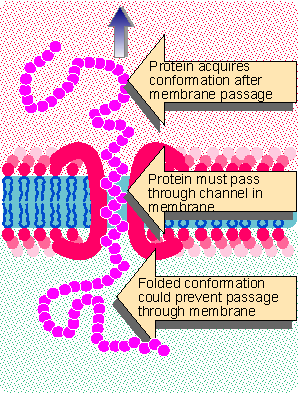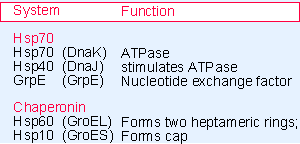2. Chaperones may be required for protein folding
8.2 Chaperones may be required for protein folding |
Protein folding takes place by interactions between reactive surfaces. Typically these surfaces consist of exposed hydrophobic side chains. Their interactions form a hydrophobic core. The intrinsic reactivity of these surfaces means that incorrect interactions may occur unless the process is controlled. For an introduction to the activities that are involved, see the supplement on Protein folding.
Some proteins are able to acquire their mature conformation spontaneously. A test for this ability is to denature the protein and determine whether it can then renature into the active form. This capacity is called self-assembly. A protein that can self-assemble can fold or refold into the active state from other conformations, including the condition in which it is initially synthesized. This implies that the internal interactions are intrinsically directed toward the right conformation.
When this does not happen, and alternative sets of interactions can occur, a protein may become trapped in a stable conformation that is not the intended final form. Proteins in this category cannot self-assemble. Their acquisition of proper structure requires the assistance of a chaperone. (For a description of the discovery that proteins require assistance to fold in vivo, see 100.4 The Discovery of Protein Folding by Chaperonins.)
Chaperones are proteins that mediate correct assembly by causing a target protein to acquire one possible conformation instead of others. This is accomplished by binding to reactive surfaces in the target protein that are exposed during the assembly process, and preventing those surfaces from interacting with other regions of the protein to form an incorrect conformation. Chaperones function by preventing formation of incorrect structures rather than by promoting formation of correct structures (for review see Ellis and Vies, 1991).
We do not know what proportion of proteins can self-assemble as opposed to those that require assistance from a chaperone. (It is not axiomatic that a protein capable of self-assembly in vitro actually self-assembles in vivo, because there may be rate differences in the two conditions, and chaperones still could be involved in vivo. However, there is a distinction to be drawn between proteins that can in principle self-assemble and those that in principle must have a chaperone to assist acquisition of the correct structure.)
The ability of chaperones to recognize incorrect protein conformations allows them to play two related roles concerned with protein structure:
- When a protein is initially synthesized, that is to say, as it exits the environment of the ribosome to enter the cytosol, it appears in an unfolded form. Spontaneous folding then occurs as the emerging sequence interacts with regions of the protein that were synthesized previously. Chaperones influence the folding process by controlling the accessibility of the reactive surfaces. This process is involved in initial acquisition of the correct conformation.
- When a protein is denatured, new regions are exposed and become able to interact. These interactions are similar to those that occur when a protein (transiently) misfolds as it is initially synthesized. They are recognized by chaperones as comprising incorrect folds. This process is involved in recognizing a protein that has been denatured, and either assisting renaturation or leading to its removal by degradation.
 |
Figure 8.4 A protein is constrained to a narrow passage as it crosses a membrane. |
Chaperones may also be required to assist the formation of oligomeric structures and for the transport of proteins through membranes. A persistent theme in membrane passage is that control (or delay) of protein folding is an important feature. Figure 8.4 shows that it may be necessary to maintain a protein in an unfolded state before it enters the membrane because of the geometry of passage: the mature protein could simply be too large to fit into the available channel. Chaperones may prevent a protein from acquiring a conformation that would prevent passage through the membrane; in this capacity, their role is basically to maintain the protein in an unfolded, flexible state. Once the protein has passed through the membrane, it may require another chaperone to assist with folding to its mature conformation in much the same way that a cytosolic protein requires assistance from a chaperone as it emerges from the ribosome. The state of the protein as it emerges from a membrane is probably similar to that as it emerges from the ribosome Xbasically extended in a more or less linear condition.
 |
Figure 8.5 Chaperone families have eukaryotic and bacterial counterparts (named in parentheses). |
Two major groups of chaperones have been well characterized, as summarized in Figure 8.5:
- The Hsp70 system consists of Hsp70, Hsp40, and GrpE. It functions on newly synthesized proteins, proteins being transported through membranes, and proteins denatured by stress. The name of the system reflects the original identification of Hsp70 as a protein induced by heat shock. The Hsp70 and Hsp40 proteins bind individually to its substrates.
- The chaperonin system consists of a large oligomeric assembly. This assembly forms a structure into which unfolded proteins are inserted.
(The connection with the heat shock response stems from the fact that increase in temperature causes production of heat shock proteins whose function is to minimize the damage caused to proteins by heat denaturation; many of the heat shock proteins are chaperones.)
| Reviews | |
| Ellis, R. J. and van der Vies, S. M. (1991). Molecular chaperones. Ann. Rev. Biochem 60, 321-347. | |